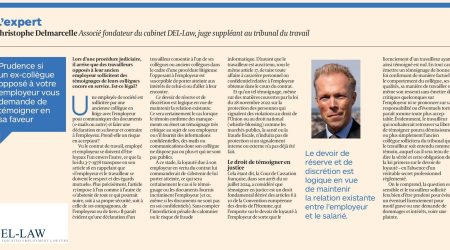Heatwave, work, maximum temperature... What are the employer's obligations?
Posted the 19 August 2020It's hot, so hot... work is becoming hell, but what should my employer do? In these days of prolonged heatwaves, where temperatures have been in excess of 30 degrees for several days, it's a good time to remember that the French law of 4 January...
It’s hot, so hot... working becomes unbearable, but what should my employer do?
During this period of prolonged heatwaves, where temperatures have exceeded 30 degrees for several days, it is worth recalling that the Law of 4 August 1996 on well-being at work and the Code on Well-being at Work (Book V, Title I, Chapters V and subsequent chapters) impose strict obligations on employers regarding heat exposure.
Every employer must first carry out a risk assessment of thermal environments in the workplace and establish preventive measures to ensure the thermal comfort of workers.
Exposure to intense heat can pose health risks (heat stroke, exhaustion, dehydration, etc.) as well as safety risks (loss of concentration, imprecise reactions or movements, etc.).
The Code sets maximum heat exposure temperatures depending on the type of work, ranging from 29 degrees WBGT (wet bulb globe temperature) for light or very light work (e.g., office tasks, driving a car), to 26 degrees for moderate work (e.g., carpentry, driving a tractor), to 22 degrees for heavy work (e.g., digging, manual sawing, planing, pushing or pulling wheelbarrows, handling goods), and to 18 degrees for very heavy work (e.g., deep digging, excavation, climbing ladders or stairs). For employees, the index for light work is typically applicable.
It is important to note that these temperatures are assessed using the WBGT index, which accounts for the perceived heat, considering not only the "dry" temperature (as measured with a standard thermometer in Celsius) but also the humidity level and, in some cases (outdoor work), wind and sun exposure. Measurements require a "wet bulb" thermometer (a device with a kind of dome at the top).
Conversion tables exist to determine the WBGT temperature using a standard thermometer and a hygrometer. For instance, with a temperature of 30 degrees Celsius, the WBGT temperature would be 26 degrees with 60% humidity but 29.6 degrees with 95% humidity. A temperature of 36 degrees Celsius would result in a WBGT of 29.3 with 45% humidity. When humidity is extremely high (e.g., 95%), the WBGT temperature approximates the reading of a standard thermometer. Lower humidity produces different results.
If the WBGT thresholds set by the Code are exceeded, the employer must implement a prevention programme established in consultation with the prevention advisor. This must include technical measures to address the exceedance, such as reducing physical workload by modifying equipment or work methods, limiting the duration and intensity of exposure, adjusting schedules and organisation (e.g., alternating work and rest periods under specific rules), providing suitable clothing, and offering free access to refreshing beverages. If not already outlined in collective agreements or internal policies, lighter, more casual clothing may also be permitted.
For breaks, recommendations are based on ISO indices, advice from occupational physicians, or supplementary guidelines in the Code. For instance, a WBGT of 29.5 for light work or 23 for heavy work may require a 15-minute break every hour, while a WBGT of 30 or more for light work or 24.5 for heavy work would necessitate 30-minute breaks every hour.
At a minimum, in the event of exceedance due to weather, the employer must install fans within 48 hours. If the exceedance persists for more than 48 hours, limited attendance schedules, rest periods, and free access to refreshing beverages must be arranged to prevent dehydration.
Employers are also responsible for monitoring the health of exposed workers and providing them with information.
These obligations apply to "workplaces," meaning any location where work is performed, whether inside or outside an establishment, and whether in a closed or open space. Since labour law explicitly excludes only domestic workers and household staff, these rules also apply to occasional or regular telework. Employers, however, have limited means of action and control in such cases, requiring flexibility. At a minimum, they should inquire about the employee’s telework conditions and provide appropriate instructions.
Notably, internal prevention services may access telework locations—with prior notification if it is a private residence—to check health and safety conditions. Employers must also inform workers about their policies in this regard. It is advisable to include clear guidelines in telework policies for periods of extreme heat, covering aspects such as flexible hours, hydration, ventilation, and instructions for contacting internal services if needed.
Teleworking may even serve as a solution during extreme heat in office settings, for example, in the event of air-conditioning failure, facilitated by occasional telework policies.
Lastly, it is worth noting that companies are also responsible for the well-being of workers from other firms engaged on their premises, as well as self-employed individuals. Thus, measures to address extreme heat must extend beyond the company's own employees to avoid liability.
A warned employer…
Related articles

Is an employer allowed to mandate the use of artificial intelligence tools by employees ? (Trends, 17-07-2025)

Caution if a former colleague opposed to your employer asks you to testify in their favor
